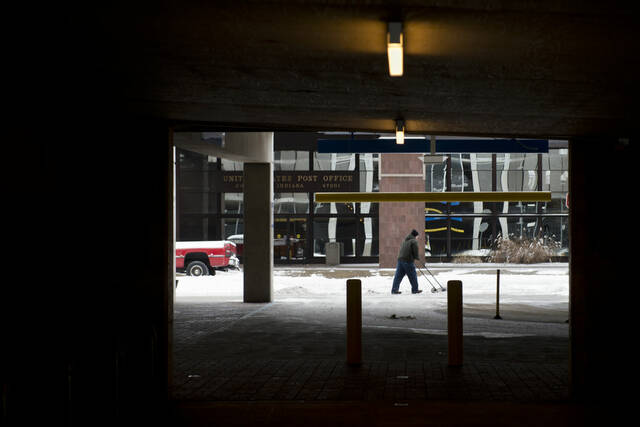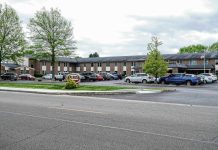
Mike Wolanin | The Republic Harold Lockhart shovels snow on in front of the parking garage on Jackson Street in downtown Columbus, Ind., Wednesday, Jan. 20, 2016.
In a recent conversation between city officials about how downtown Columbus parking has changed since 2013, the old adage seemed to be true — the more things change, the more they stay the same.
During a recent meeting of the Columbus Parking Commission, representatives from Nelson/Nygaard asked questions about the current state of downtown parking in the city and how it may have changed since the firm’s 2013 study of the situation.
And despite the impacts of COVID-19 — such as a number of employees switching to remote work — officials continue to see the need to improve upon the current system.
Nelson/Nygaard is conducting an update to its previous parking study at the request of the parking commission. However, due to the commission’s inability to contract or receive funds, the work is being funded through a $19,470 grant from the Columbus Redevelopment Commission to the Board of Works, with the latter serving as the contracting entity. The contract was approved in late 2021.
According to city documents, the original 2013 study cost almost $85,000 and was also funded by the redevelopment commission.
Project Manager Tom Brown with Nelson/Nygaard said that the firm is now tasked with bringing the study “up to date.”
“Originally, the (study update) conversation was largely about the meter purchase and the recommendations,” he said. “And the feeling was, to add priced parking on-street downtown was a good one, but it’s been eight years. …We need some guidance on putting that into action, being smart about procurement.”
The job isn’t just to advise on meters, but also to “take a few steps back” and see what has — or hasn’t — changed from 2013, Brown said.
Nelson/Nygaard’s conversation with the commission was the first of a series of stakeholder discussions. The firm is looking to engage with individuals who can speak to the past, present and possible future of downtown parking conditions. They also want to hear what people think about the original study’s recommendations.
According to Brown, the 2013 study found that 59% of visitors and customers surveyed preferred on-street parking. Within that set, Washington Street was the “predominately mentioned street” that people looked to as a first choice for parking.
Utilization surveys showed that available parking on Washington — or adjacent streets — was difficult to find during a number of time periods on weekdays and Saturdays.
Consequently, one of the firm’s main recommendations was to implement priced parking.
“When we find that there’s actually plenty of parking across downtown but people are finding it inconvenient and they’re all kind of looking along the same street — or within the same core area — we recommend pricing not so much as a revenue generator … but it’s a reason to start looking for parking on other streets,” said Brown.
The firm also recommended educating people about free parking and the best options for employees.
The areas recommended for pricing were Washington from Second to Seventh Street and Fourth and Fifth Streets from Jackson to Franklin. When he asked if this was still a good representation of the “downtown core,” commission member Kevina Schumaker added that Franklin also sees some on-street parking near Fifth Street that isn’t related to the nearby businesses.
City Councilman and Commission Chairman Tom Dell said that the area was left as all-day free parking for downtown entry-level employees.
“You have to maintain a certain inventory of available free parking for them, otherwise you push them dramatically into the neighborhoods,” he explained.
Commission member Catie Rix then asked about the possibility of encouraging employees to use the upper levels of downtown parking garages to free up on-street parking for customers. Brown said he believed the firm had made a similar recommendation wherein the upper level would be set aside for employees.
However, he also noted that there needs to be an incentive for employees to use the space, given the lack of convenience.
According to the city’s website, both the Jackson Street and Second Street parking garages are owned and operated by the city under the direction of the redevelopment commission. Dell noted that garage revenue helps offset some of the their costs of operation, which complicates the idea of reducing rates.
Per the department’s website, the Jackson Street garage is open 24/7, with parking charged from 6 a.m. to 8 p.m. on weekdays and the first hour being free. Parking is also free after hours and on weekends. The top floor is the exception to the 24/7 rule; it closes at 8 p.m., and all cars are expected to be off the roof by that time.
According to Dell, the garage’s upper level is closed due to problems such as winter weather, vandalism, and people hanging out up there. He said that level is only open during major downtown events.
Of the other two downtown garages, one is solely for Cummins employees. The other is a mix of spaces reserved for The Cole, Cummins, and retail, though it is available to the public during certain hours.
The Second Street garage, according to the redevelopment department, does not have daily parking rates and reserves monthly parking rates for Cole tenants and Cummins employees. However, it is free and open to the public “Monday — Friday evenings and weekends 6 p.m. to 6 a.m.” The top floor closes at 8 p.m.
The city also has a couple of downtown lots where parking spots can be leased, said Dell.
“Often why parking gets mispriced in downtown in terms of like — the market everyone wants is free and there’s no availability, and the parking where people use as a second resort costs money,” said Brown. “It costs money to build the garage. It costs money to maintain a lot. So it’s sort of natural to charge of those spaces, whereas it feels like ‘Well, on-street parking’s there already. It’s a nice gesture to make it free.’”
This then leads to frustration for patrons when on-street parking is unavailable, and they have to pay to park somewhere else. However, he added that it’s good to offer a free period, which helps to reduce some of the frustration caused by the inconvenience.
Commission member and downtown business owner Jeff Baker also noted that the current downtown parking system — which limits parking in certain areas, such as Washington Street, to three hours during the workday — can be frustrating to people who park downtown for, say, five minutes and return later in the afternoon, only to receive a ticket as if they had been there the entire time.
Schumaker said she’s seen business owners move spots to try to avoid fees, hence the current policy. However, it’s hard to explain the system to a well-meaning customer who returns to downtown twice in one day.
“This is one of the reasons why we often lead with pricing,” said Brown, “because if I’m coming downtown once a month, paying a couple of dollars for really great parking is not a big deal. But if I’m there every day, that little bit of extra cost — I’m going to look for something cheaper. Whereas trying to do it through enforcing time limits — people who are there all the time figure out ways to game the system, and it’s the visitor who comes and gets caught up in something that was well-intentioned.”
While parking problems may be less severe than they were prior to COVID-19, there city should be prepared for future shifts.
“Pre-pandemic, as we got further and further way from 2013, I realized the need more and more to implement something in parking, because we were having a constant problem,” said Baker. “And granted, there’s not a significant problem right now. But I would suspect that in another six months, we’re going to start seeing significant changes.”
In wrapping up the discussion, Brown said that the commission’s feedback was “somewhat familiar,” though he expected to also hear about some unique circumstances during the stakeholder engagement process.
The firm is compiling a list of names and organizations to include in conversations, such as businesses, and possibly residences or home associations. They also expect to speak with more city staff, including those who involved with maintaining lots and garages or relevant policy decisions such as pricing.
Brown said that they would also welcome recommendations from the commission as to individuals that should be included.
Nelson/Nygaard’s scope of work for the study update includes four key tasks — project start-up and coordination, stakeholder engagement, updated recommendations and “meter procurement guidance.”
Brown added that the last step would take place assuming that meter procurement is still a priority.
“That can also be a combination of other guidance on implementing strategies that we recommend,” he said.
“At the end of each phase, the parking commission will take note and see if we’re ready to move forward for the next phase,” said Redevelopment Director Heather Pope in late 2021. “…If at any point in time the parking commission decides to not move forward to the next phase, then any remaining funds that are left will be transferred back to the redevelopment commission.”
City Engineer Dave Hayward said at the time that each step will likely take one to two months for an estimated total of about six to eight months overall.




